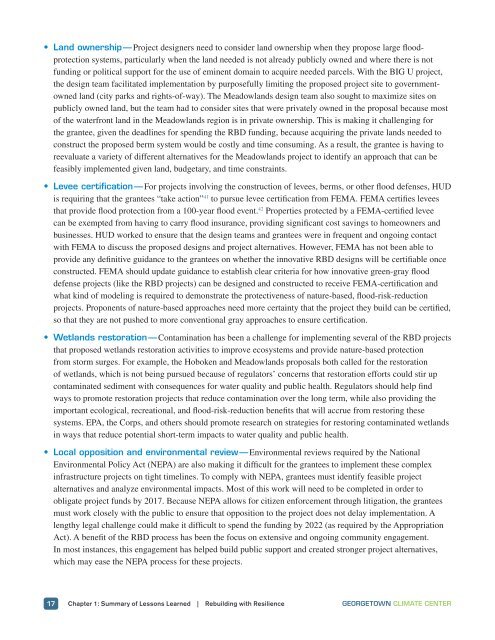Rebuilding with Resilience
dw0r306aHfX
dw0r306aHfX
Create successful ePaper yourself
Turn your PDF publications into a flip-book with our unique Google optimized e-Paper software.
• Land ownership — Project designers need to consider land ownership when they propose large floodprotection<br />
systems, particularly when the land needed is not already publicly owned and where there is not<br />
funding or political support for the use of eminent domain to acquire needed parcels. With the BIG U project,<br />
the design team facilitated implementation by purposefully limiting the proposed project site to governmentowned<br />
land (city parks and rights-of-way). The Meadowlands design team also sought to maximize sites on<br />
publicly owned land, but the team had to consider sites that were privately owned in the proposal because most<br />
of the waterfront land in the Meadowlands region is in private ownership. This is making it challenging for<br />
the grantee, given the deadlines for spending the RBD funding, because acquiring the private lands needed to<br />
construct the proposed berm system would be costly and time consuming. As a result, the grantee is having to<br />
reevaluate a variety of different alternatives for the Meadowlands project to identify an approach that can be<br />
feasibly implemented given land, budgetary, and time constraints.<br />
• Levee certification — For projects involving the construction of levees, berms, or other flood defenses, HUD<br />
is requiring that the grantees “take action” 41 to pursue levee certification from FEMA. FEMA certifies levees<br />
that provide flood protection from a 100-year flood event. 42 Properties protected by a FEMA-certified levee<br />
can be exempted from having to carry flood insurance, providing significant cost savings to homeowners and<br />
businesses. HUD worked to ensure that the design teams and grantees were in frequent and ongoing contact<br />
<strong>with</strong> FEMA to discuss the proposed designs and project alternatives. However, FEMA has not been able to<br />
provide any definitive guidance to the grantees on whether the innovative RBD designs will be certifiable once<br />
constructed. FEMA should update guidance to establish clear criteria for how innovative green-gray flood<br />
defense projects (like the RBD projects) can be designed and constructed to receive FEMA-certification and<br />
what kind of modeling is required to demonstrate the protectiveness of nature-based, flood-risk-reduction<br />
projects. Proponents of nature-based approaches need more certainty that the project they build can be certified,<br />
so that they are not pushed to more conventional gray approaches to ensure certification.<br />
• Wetlands restoration — Contamination has been a challenge for implementing several of the RBD projects<br />
that proposed wetlands restoration activities to improve ecosystems and provide nature-based protection<br />
from storm surges. For example, the Hoboken and Meadowlands proposals both called for the restoration<br />
of wetlands, which is not being pursued because of regulators’ concerns that restoration efforts could stir up<br />
contaminated sediment <strong>with</strong> consequences for water quality and public health. Regulators should help find<br />
ways to promote restoration projects that reduce contamination over the long term, while also providing the<br />
important ecological, recreational, and flood-risk-reduction benefits that will accrue from restoring these<br />
systems. EPA, the Corps, and others should promote research on strategies for restoring contaminated wetlands<br />
in ways that reduce potential short-term impacts to water quality and public health.<br />
• Local opposition and environmental review — Environmental reviews required by the National<br />
Environmental Policy Act (NEPA) are also making it difficult for the grantees to implement these complex<br />
infrastructure projects on tight timelines. To comply <strong>with</strong> NEPA, grantees must identify feasible project<br />
alternatives and analyze environmental impacts. Most of this work will need to be completed in order to<br />
obligate project funds by 2017. Because NEPA allows for citizen enforcement through litigation, the grantees<br />
must work closely <strong>with</strong> the public to ensure that opposition to the project does not delay implementation. A<br />
lengthy legal challenge could make it difficult to spend the funding by 2022 (as required by the Appropriation<br />
Act). A benefit of the RBD process has been the focus on extensive and ongoing community engagement.<br />
In most instances, this engagement has helped build public support and created stronger project alternatives,<br />
which may ease the NEPA process for these projects.<br />
17 Chapter 1: Summary of Lessons Learned | <strong>Rebuilding</strong> <strong>with</strong> <strong>Resilience</strong> GEORGETOWN CLIMATE CENTER


